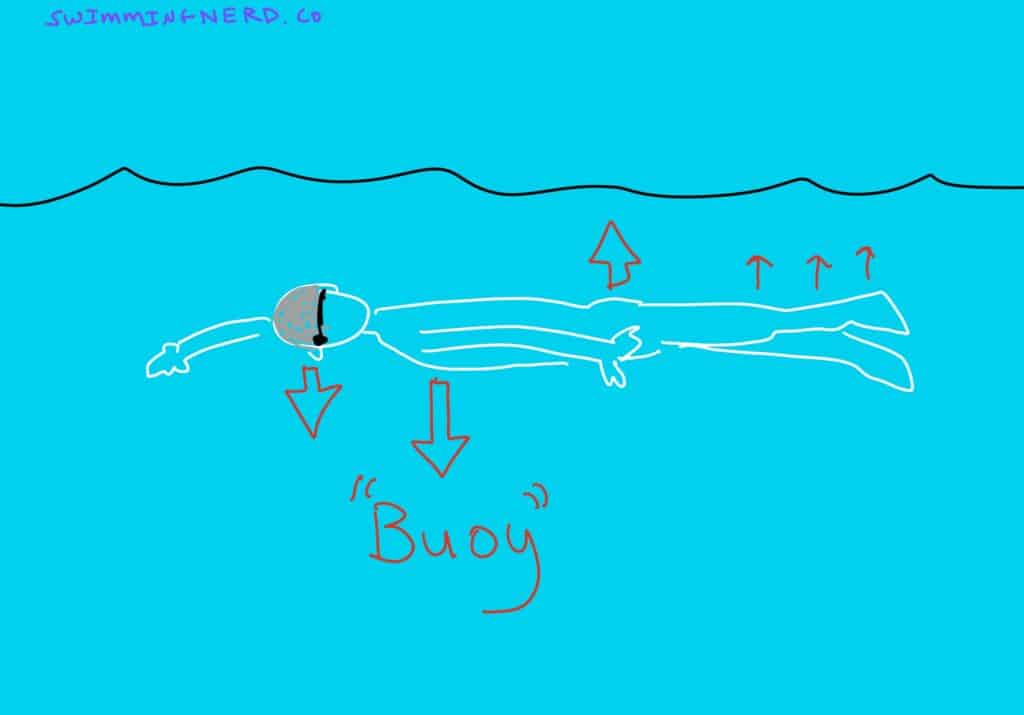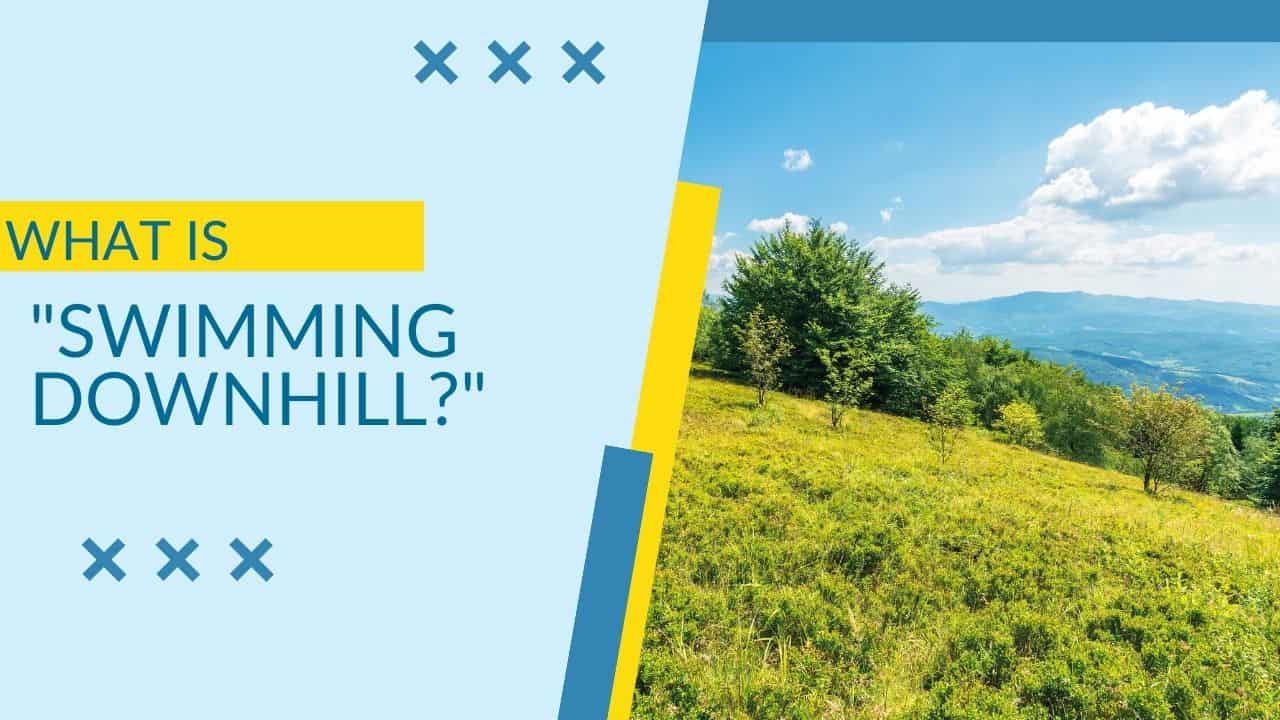Swimming is a great way to stay active and improve your overall health and fitness.
But with so many techniques and philosophies (and lingo) out there, it can be overwhelming to know where to start.
And Total Immersion is absolutely FULL of Terry’s lingo & ideas.
But what does “swimming downhill” actually mean?
“Swimming downhill” is a phrase coined by Terry Laughlin, the founder of Total Immersion, to describe the sensation of swimming with proper technique. When you swim with proper TI technique, the water should flow over your body, making it easier and more effortless to swim, and it should feel like “swimming downhill.” It basically means you’re using proper technique and the natural buoyancy of your body to swim efficiently.
Table of Contents
- What is Total Immersion Swimming?
- What does “swimming downhill” actually mean?
- How to “Swim Downhill” with Total Immersion Swimming
- Total Immersion F.A.Q.s
Please do not confuse my personal blog for medical advice. Please consult with a healthcare professional before starting or altering any training plan. This post may contain affiliate links. If you make a purchase after clicking on a link, I get a small percentage of the sale at no additional cost to you.
I’m a big fan of the TI techniques (especially for new swimmers!).

Let’s jump in (to the pool!) with more details:
What is Total Immersion Swimming?
Total Immersion Swimming was founded by Terry Laughlin, a world-renowned swim coach and author. Laughlin developed the technique as a way to help swimmers of all levels improve their technique, speed, and efficiency in the water.
He based Total Immersion Swimming on the idea that swimming should be effortless and natural, like “swimming downhill.”
This is a technique that focuses on proper body position, body rotation, and a long, natural stroke. Unlike traditional swimming techniques, which can sometimes rely on brute force and strength (“more laps!!”), Total Immersion Swimming emphasizes a more relaxed and efficient approach to swimming.

This technique can be used by anyone, from beginners to experienced swimmers, and is designed to help you swim faster, farther, and with less effort.
The key principles of Total Immersion Swimming include:
- Proper body position in the water
- Body rotation for a more efficient and natural stroke
- A long, natural stroke that utilizes the body’s natural buoyancy
- Relaxation in the water reduces resistance and increase speed
- By mastering these principles, you can achieve the sensation of “swimming downhill” and enjoy a more efficient and effortless swim.
What does “swimming downhill” actually mean?
“Swimming downhill” means that you’re swimming with proper technique and using your body’s natural buoyancy to swim efficiently.
When you’re “swimming downhill,” you should feel weightless and relaxed in the water, allowing you to swim faster and for longer distances with less effort.

Proper technique is everything.
By focusing on proper body position, body rotation, and a long, natural stroke, you can reduce resistance in the water and swim more efficiently. With time and practice, you’ll be able to swim with proper technique and reach the sensation of “swimming downhill.”
How to “Swim Downhill” with Total Immersion Swimming
Here are some general tips to achieve that “weightless” body position that allows you to effortlessly glide through the water:
Practice proper body position in the water:
To “swim downhill” with Total Immersion Swimming, you need to position your body properly in the water. This means keeping your head facing straight down, pressing down your chest (see below), and keeping your legs up.
By maintaining this position, you reduce “drag” in the water and make it easier to swim efficiently.
This is definitely not natural for new swimmers, and requires lots of practice!
PRO TIP: Mastering rhythmic breathing (turning your body & head to breathe during the stroke) is essential for being able to keep your head pointed down.
Utilize your body’s natural buoyancy for a long, natural stroke:
This basically just means pressing your “buoy,” or your chest area, downwards while swimming.
Your chest area (lungs!) hold the majority of air in your body, much like a balloon. You’ll want to press the balloon DOWN.
This will naturally cause the bottom half of your body to rise upward, creating a much more efficient & hydrodynamic body position.
Relax your body:
Relaxation is KEY in Total Immersion Swimming. The entire goal is to increase distance without doing more work, and the more you tense/flex your muscles, the quicker you’ll get tired!
Make sure to keep your shoulders and arms relaxed and avoid tensing up as you swim. This can take some practice, but with time you’ll be able to swim more efficiently and with less effort.
Focus on body rotation:
Body rotation is another important aspect of Total Immersion Swimming. By rotating your body as you swim, you create a more efficient and natural stroke.
In fact, many TI “drills” focus on swimming on your side (without rotating at all, just to practice what it feels like to point your shoulder completely down).
This helps you swim faster and with less effort, allowing you to reach the sensation of “swimming downhill.”
Total Immersion F.A.Q.s
Can you swim faster with Total Immersion Swimming?
By focusing on proper body position, body rotation, and a long, natural stroke, Total Immersion Swimming can lead to more efficient swimming. When you swim with proper technique, you reduce resistance in the water, allowing you to swim faster with less effort. This is the essence of “swimming downhill.”
Is Total Immersion Swimming worth it?
Whether or not Total Immersion Swimming is worth it depends on your individual goals and needs as a swimmer. If you’re looking to improve your technique, speed, and endurance in the water, Total Immersion Swimming can be a great way to achieve these goals.
By focusing on proper body position, body rotation, and a long, natural stroke, you can swim more efficiently and with less effort. However, it does require time and effort to master the technique, so it’s important to consider whether it aligns with your own goals and priorities as a swimmer.
At the very least, I recommend picking up Terry’s book on Amazon!

About the author
Hi! I’m Sam. And I’m a nerd. Swimming Nerd. Gear Nerd. Triathlon Nerd. I swam in high school and have even done a few sprint and Olympic distance triathlons. I’m excited to share my love of swimming with you through this site!

